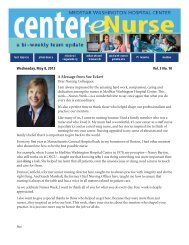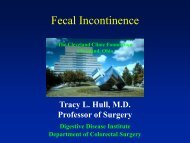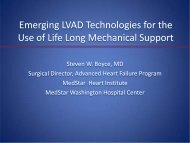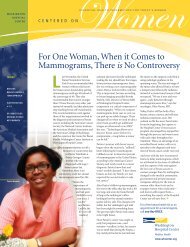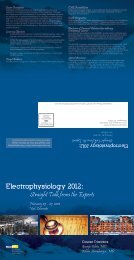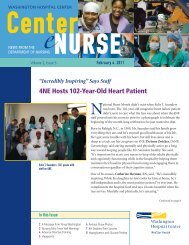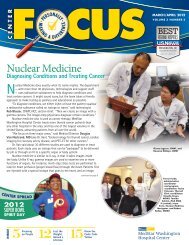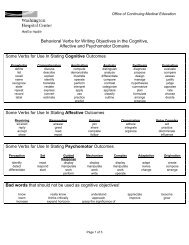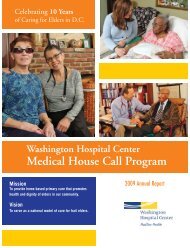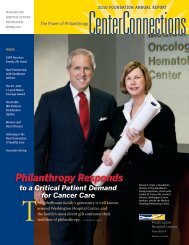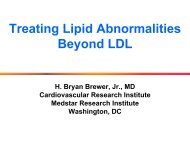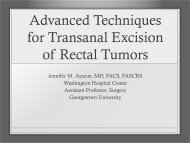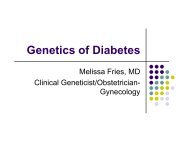Cardiovascular MRI: The Future is Now - Washington Hospital Center
Cardiovascular MRI: The Future is Now - Washington Hospital Center
Cardiovascular MRI: The Future is Now - Washington Hospital Center
Create successful ePaper yourself
Turn your PDF publications into a flip-book with our unique Google optimized e-Paper software.
Assessment of Viability with CMR: What<br />
<strong>is</strong> the Value After the STICH Trial?<br />
Chr<strong>is</strong>topher M. Kramer MD<br />
Ruth C. Heede Professor of Cardiology<br />
Professor of Radiology<br />
Director, <strong>Cardiovascular</strong> Imaging <strong>Center</strong><br />
University of Virginia Health System
Noninvasive assessment of viability<br />
1. Quantitative SPECT<br />
• > 50 % uptake of tracer ( 201 Tl, sestamibi, tetrofosmin)<br />
2. PET imaging<br />
• m<strong>is</strong>match between flow and metabol<strong>is</strong>m (FDG)<br />
3. FDG SPECT<br />
4. Low dose dobutamine echocardiography<br />
• inotropic reserve<br />
5. Contrast echocardiography<br />
• integrity of microcirculation<br />
6. CMR<br />
• inotropic reserve; late gadolinium enhancement
Viability testing and outcomes<br />
Annual Cardiac Death Rate (%)<br />
20<br />
16<br />
12<br />
8<br />
4<br />
0<br />
3.2<br />
-80%<br />
p
Viability imaging – does it matter?<br />
430 patients<br />
Randomized to PET<br />
guided arm vs. standard<br />
care<br />
Death, MI, or cardiac<br />
hospitalization<br />
Benefits in those who<br />
adhered to PET<br />
recommendations<br />
Beanlands R et al, J Am Coll Cardiol 2007;50:2002-12
STICH Trial<br />
Velasquez EJ et al, NEJM 2011;364:1607-16
STICH Trial<br />
Bonow RO et al, NEJM 2011;364:1617-25
Limitations of STICH<br />
Crossover in 17% medical arm, 9 % in CABG arm<br />
Small proportion randomized<br />
2 patients per site randomized per year on average<br />
Viability substudy pts. not randomized<br />
Viability testing optional – only ½ of pts. from main trial<br />
Differences in baseline character<strong>is</strong>tics<br />
Limited tests for viability – DSE, SPECT<br />
Binary classification of viability<br />
Revascularization not guided by presence of viability<br />
Small n with nonviability<br />
P Chareonthaitawee et al, JACC Img 2012;5:550-8
Viability by CMR<br />
Late gadolinium enhancement<br />
Dobutamine – contractile reserve<br />
Techniques<br />
Applications – acute MI, chronic <strong>is</strong>chemia<br />
Prognos<strong>is</strong>
Infarct detection/transmurality<br />
Technique - inversion recovery, nulling of<br />
normal myocardial signal<br />
Infuse 0.15 mM/kg of Gd-DTPA<br />
Image 10-20 minutes later –<br />
Gd becomes trapped<br />
in necrotic scar,<br />
delayed washout<br />
Simonetti et al Radiology 2001;218:215
Viability - Delayed hyperenhancement<br />
Kim, RJ et al Circulation 1999;100:1992-2002
Size of HE<br />
Choi et al Circulation 2001;104:1101-1107
Transmural extent of HE<br />
Transmural extent of hyperenhancement<br />
(%)= area A x 100 / (area A + area B)<br />
Kim, et al. N Engl J Med 2000;343: 1445-53
Reproducibility<br />
48 pts., 3 centers<br />
Imaged x 2, 0.15mM/kg Gd<br />
Wagner A et al. J Am Coll Cardiol<br />
2006;47:2027-33
Improved sensitivity vs. SPECT<br />
6 pts. (13%) with<br />
subendocardial<br />
infarction had no<br />
evidence of<br />
infarction by SPECT<br />
85/181 segments with<br />
subendocardial<br />
infarction had<br />
negative SPECT<br />
Wagner A, et al. Lancet 2003;9355:374
SPECT vs. CMR<br />
78 pts. acute MI at day 7<br />
Ibrahim T et al, J Am Coll Cardiol, 2007;49:208-16
Detecting unrecognized infarcts<br />
ICELAND MI study<br />
936 pts., 67-93 yrs.<br />
91 recognized MI<br />
157 unrecognized MI<br />
6.4 yrs. f/u<br />
Adjusted HR 1.45<br />
Absolute r<strong>is</strong>k↑ 8%<br />
Schelbert E et al, JAMA, 2012;308:890-896
LGE and prognos<strong>is</strong><br />
Kwong, RY et al.<br />
Circulation 2006;<br />
113:2733-2743
Acute MI - Contrast patterns<br />
Hyperenhancement Hyperenhancement +<br />
Microvascular obstruction
Regional function<br />
%S<br />
30<br />
25<br />
20<br />
15<br />
10<br />
5<br />
0<br />
*p
Pers<strong>is</strong>tent hypoenhancement - no-reflow<br />
Event-free survival (CV death,<br />
reinfarction, CHF, or stroke) for<br />
patients with and without <strong>MRI</strong> no<br />
reflow<br />
Wu, KC. Circulation 1998;97:765-772.
Time to reperfusion<br />
Tarantini G et al, J Am Coll Cardiol 2005;46:1229-1235
Infarct involution<br />
Ingkan<strong>is</strong>orn WP et al, J Am Coll Cardiol, 2004;43:2253<br />
Choi CJ et al, J Cardiovasc Magn Reson, 2004;6:915-23
AMI – T2-W edema imaging – area at r<strong>is</strong>k<br />
Abdel-Aty H et al.<br />
J<strong>MRI</strong> 2007;26:452-9<br />
Friedrich M et al.<br />
J Am Coll Cardiol<br />
2008;51:581-7
T2-W – edema/area at r<strong>is</strong>k<br />
Day 0 Day 1
T2-W – edema/area at r<strong>is</strong>k
T2-W/prognos<strong>is</strong><br />
Eitel I et al<br />
JACC<br />
2010;<br />
55:2470-9
Hibernation - Late gadolinium enhancement<br />
50 pts. imaged before revascularization<br />
804/2093 segments dysfunctional at baseline<br />
694/2093 had areas of hyperenhancement<br />
Kim R et al. N Engl J Med. 2000;343:1445
Viability – Late gadolinium enhancement<br />
Kim R et al. N Engl J Med. 2000;343:1445
LGE vs. PET<br />
31 pts., <strong>is</strong>chemic LV dysf., EF 28±9%<br />
PET and delayed enhancement <strong>MRI</strong><br />
11% PET viability showed some HE<br />
C Klein Circulation 2002;105:162
LGE vs. PET<br />
26 pts. w/ LV dysf.<br />
EF 31 11%<br />
FDG-PET, SPECT,<br />
and CMR<br />
17-segment model<br />
HP Kuhl et al. J Am Coll Cardiol 2002;105:162
Viability – Late gadolinium enhancement<br />
Kim et al, N Engl J Med<br />
2000;343:1445
Viability - dobutamine cine <strong>MRI</strong><br />
Functional recovery as gold standard (SWT >2mm)<br />
Sens. 89%, Spec. 94%, better than EDWT<br />
↑EF with contractile reserve (14±9% vs. 3±9%, )<br />
Baer et al, JACC<br />
1998:31:1040
Viability - dobutamine tagged <strong>MRI</strong><br />
17 patients (12 male)<br />
Age 63 9<br />
Ischemic LV dysfunction<br />
<strong>MRI</strong> before and 5 2<br />
months after revasc.<br />
Baseline 5 µg/kg/min Dob<br />
10 µg/kg/min Dob<br />
Follow up<br />
Samady et al, Circulation, 2004;110:2410-6
Results<br />
All 180 Segments<br />
Rest %S<br />
Postrevascularization<br />
40<br />
30<br />
20<br />
10<br />
0<br />
-10<br />
-20<br />
y = 0.61x +5.4<br />
r = 0.55, P < 0.001<br />
-10<br />
0<br />
Peak dobutamine %S<br />
Pre-revascularization<br />
10<br />
20<br />
Samady et al, Circulation, 2004;110:2410-6<br />
30<br />
40
Example images – nonviable segment<br />
30% HE<br />
Baseline Dobutamine<br />
Follow-up<br />
nonviable<br />
C Bove et al, Radiology<br />
2006; 240:835-41
Subendocardial MI – 1-50% HE<br />
C Bove et al, Radiology<br />
2006; 240:835-41<br />
* p
Contrast vs. dobutamine<br />
All<br />
segments<br />
1-75%<br />
TEH<br />
No scar or<br />
transmural<br />
scar<br />
25% or 50%<br />
cutoff<br />
Wellnofer et al, Circulation<br />
2004;109:2172-2174
Meta-analys<strong>is</strong><br />
J Romero et al, JACC CV<br />
Imaging 2012;5:509-12
Conclusions<br />
If viability <strong>is</strong> of interest in clinical dec<strong>is</strong>ion<br />
making, CMR <strong>is</strong> an excellent technique to use<br />
Late gadolinium enhancement <strong>is</strong> a well-validated,<br />
accurate method of infarct sizing<br />
Prognostic information of LGE continues to grow<br />
Late gadolinium enhancement and low dose<br />
dobutamine contractile reserve are<br />
complementary in the assessment of likelihood<br />
of contractile recovery



